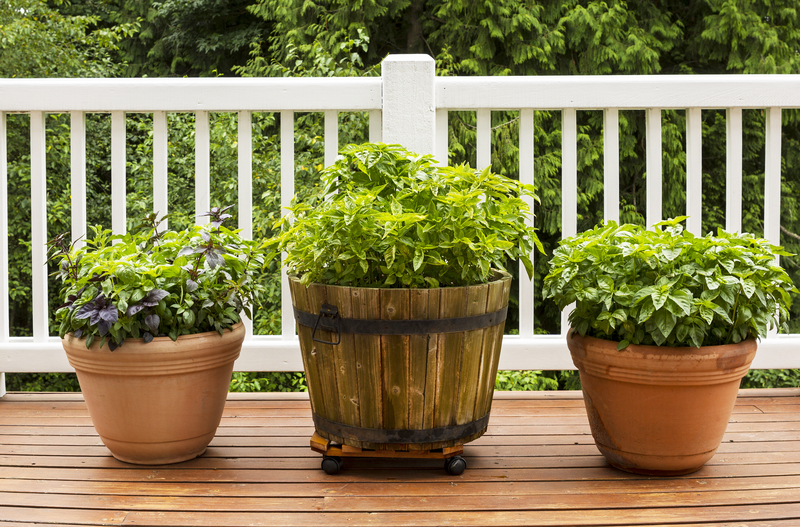Envision a Restful Landscape with Zen Garden Arrangements
Posted on 29/08/2025
Envision a Restful Landscape with Zen Garden Arrangements
In a world where noise, stress, and chaos dominate much of our daily environment, the quest for tranquility and inner peace is more valuable than ever. Imagine stepping into your backyard and being immediately enveloped by a calm, contemplative space, where every stone, ripple of sand, and carefully chosen plant is designed to promote relaxation. This is the essence of Zen garden arrangements--a harmonious and beautiful approach to landscaping that soothes the mind and nurtures the spirit.
What is a Zen Garden? A Brief Introduction
Zen gardens, also known as Karesansui (dry landscape gardens), are a traditional part of Japanese culture, dating back centuries. These serene landscapes feature minimalistic arrangements of rocks, gravel or sand, moss, and carefully selected plants to evoke a sense of peace and contemplation.
- Origins: Zen gardens originated in 12th-century Japan, deeply rooted in Buddhist and Shinto philosophies.
- Key element: The use of symbolic forms and textures, such as rocks representing mountains or islands, and sand or gravel raked to mimic flowing water.
- Purpose: Designed as spaces for meditation, reflection, and connection to nature, allowing practitioners to focus their thoughts and relax their mind.
Zen garden landscaping has since evolved, with modern interpretations worldwide embracing the minimalist principles and the timeless aesthetic appeal of these peaceful gardens.

The Principles Behind Zen Garden Landscaping
To envision a restful landscape with Zen garden arrangements, it's important to understand their underlying principles. The concept of 'less is more' prevails in these gardens, meaning every element is both functional and symbolic.
Simplicity (Kanso)
Simplicity dictates that arrangements remain uncluttered; excess is removed so only the most essential elements remain. Every stone and plant has significance.
Asymmetry (Fukinsei)
Unlike Western gardens that may favor symmetry, Zen landscapes thrive on balance through asymmetry--creating visual harmony while embracing natural imperfections.
Naturalness (Shizen)
Elements are placed to look organic and uncontrived, as if they have naturally come together over time. This naturalness fosters a deep connection between the observer and the landscape.
Tranquility (Seijaku)
The ultimate goal of any Zen garden arrangement is to foster a sense of deep tranquility, providing a sanctuary away from modern life's distractions.
Elements of Zen Garden Arrangements
Modern Zen-inspired landscape designs bring together traditional elements with personal touches to create unique sanctuaries. Below are key components you should consider for a restful Zen landscape:
- Rocks and Stones: Symbolize mountains, islands, or animals. Their placement is intentional, often representing philosophical ideas or natural landscapes.
- Gravel or Sand: Raked to create ripples, representing the flow of water or energy. The act of raking itself is a form of moving meditation.
- Moss: Used to soften hard lines, add texture, and symbolize steadfast endurance.
- Water Features: Although not always present, small ponds or bamboo fountains can add soothing auditory elements to the environment.
- Plants: Selected for form and subtle color--think evergreens, bamboos, maples, and azaleas that provide year-round interest without overpowering the landscape.
- Bridges and Lanterns: Often included as focal points, representing the transition from the mundane world to a spiritual realm.
How to Design Your Own Zen Garden Landscape
Ready to create a restful Zen space at home? Here's a comprehensive step-by-step guide to envisioning and designing a peaceful Zen garden arrangement tailored to your unique space.
1. Select the Right Location
Choose a quiet space that feels separate from daily activity. It could be a backyard corner, a courtyard, or even a rooftop. The primary requirement is that it invites contemplation and relaxation.
2. Plan Your Layout
- Sketch a design on paper, accounting for rocks, sand, and plant placements. Consider how your eye will travel through the landscape.
- Use odd numbers of stones and plant groupings for a more natural feel.
3. Choose and Arrange Stones
- Stones are the backbone of a traditional Zen garden. Large standing stones suggest mountains; smaller, flat stones evoke islands.
- Partially bury them to enhance a sense of age and permanence.
4. Lay Gravel or Sand
- Spread a layer of fine gravel or sand. This serves as the garden's canvas.
- Use a Zen rake (or a regular garden rake) to shape rippling patterns, symbolizing water's gentle flow. Alter patterns as seasons change or to reflect your current mood.
5. Add Moss and Minimal Plantings
- Moss thrives in shaded, moist areas--perfect for Zen gardens. Plant it around rocks or along borders for softness and texture.
- Use restrained greenery: dwarf pines, bamboo, Japanese maples, or azaleas lend subtle beauty without overpowering the calm.
6. Incorporate Features and Ornaments
- Add a stone lantern, bamboo water spout, low bridge, or even a simple bench for quiet reflection. Ensure that each item has a purpose within your garden's theme.
7. Maintain Mindful Simplicity
Regularly tidy leaves, prune plants, and refresh patterns in the gravel or sand to preserve order and peace. The act of maintenance is as meditative as the garden itself!
Best Plants for Zen Garden Arrangements
While a traditional Zen arrangement focuses primarily on rocks and sand, plants are vital for providing life, color, and seasonal change. Choose low-maintenance species that accentuate the restful mood of the space.
- Moss: Ideal for shaded areas, moss adds softness and a sense of age.
- Bamboo: Known for its upright grace and gentle movement, bamboo creates visual interest and privacy.
- Japanese Maple (Acer palmatum): Their fine foliage and vibrant seasonal color add a dynamic touch.
- Dwarf Pines: Hardy and sculptural, they suggest mountains in miniature.
- Azaleas and Camellias: Offer brief but stunning blooms, a subtle reminder of nature's cycles.
Benefits of a Zen-Inspired Restful Landscape
Why choose a Zen garden arrangement? The benefits extend far beyond aesthetics.
- Mental Clarity: The simplicity and order of a Zen landscape encourage mindfulness and help clear clutter from your mind.
- Stress Reduction: The soothing visuals, sounds, and tactile experiences provided by rocks, sand, and water features are proven to lower stress.
- Year-Round Beauty: Minimalist plantings and hardscape elements maintain appeal in every season.
- Low Maintenance: Zen-inspired gardens can require less upkeep than lush Western gardens, especially when designed with gravel, stones, and slow-growing plants.
- Personal Sanctuary: Offers a quiet place for meditation, reflection, or simply escaping the noise of everyday life.
Creative Zen Garden Ideas for Every Space
With some imagination, you can adapt Zen garden arrangements to any environment, big or small. Here are ideas to inspire your transformation:
Mini Tabletop Zen Gardens
Perfect for offices or apartment dwellers. Fill a shallow tray with sand, add a few artfully arranged stones, and a miniature rake. This scaled-down version still offers moments of calm and tactile meditation wherever space is limited.
Balcony or Rooftop Zen Retreat
Create privacy with bamboo screens, raised planters of evergreen shrubs, a small trickling fountain, and a few well-placed rocks. The rooftop breeze only enhances the garden's tranquil ambiance.
Woodland Zen Courtyard
Blend the principles of Zen gardening into shady, tree-lined spaces. Use moss, ferns, and stone lanterns tucked among natural boulders. A winding path of stepping stones adds a sense of journey and discovery.
Traditional Backyard Zen Garden
Design a larger arrangement with sweeping gravel patterns, multiple standing stones, and sculptural pines. Add a secluded bench or tea house overlooking the composition for an authentic meditation experience.

Common Mistakes to Avoid in Zen Garden Landscaping
While there is room for personal interpretation, certain pitfalls can disturb the serenity a Zen garden arrangement strives for. Keep these tips in mind:
- Overcrowding: Too many plants or ornaments clutter the landscape and confuse the eye.
- Ignoring Maintenance: Allowing leaves to accumulate or sand to get messy undermines the peaceful appearance.
- Lack of Symbolism: Adding random elements without thought can make the garden seem inauthentic. Be intentional with every inclusion.
- Neglecting Balance: Maintain the subtle harmony of shapes, textures, and empty space that defines Zen garden design.
Conclusion: Crafting Your Restful Zen Landscape
To envision a restful landscape with Zen garden arrangements is to imagine a space in which beauty, tranquility, and mindfulness converge. Whether you choose a classic Karesansui in your backyard or a simple miniature Zen arrangement on your desk, the principles remain the same: simplicity, balance, and a deep respect for nature.
Designing a Zen-inspired garden is more than a landscaping project; it's a journey toward peace of mind and a more harmonious lifestyle. Every stone you place, every ripple you rake, brings you one step closer to your own serene sanctuary.
Ready to Transform Your Space?
Start today--sketch your vision, gather your chosen materials, and create your unique Zen garden retreat. Envision, arrange, and enjoy a restful landscape that will refresh your soul for years to come.
For more tips on garden design, meditation practices, and inspiration for peaceful living, explore our other articles on landscaping and mindful spaces.

